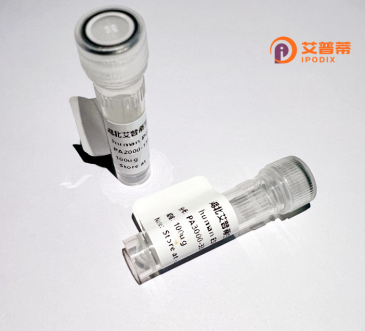
| 纯度 | >90%SDS-PAGE. |
| 种属 | Human |
| 靶点 | PAQR3 |
| Uniprot No | Q6TCH7 |
| 内毒素 | < 0.01EU/μg |
| 表达宿主 | E.coli |
| 表达区间 | 1-269 aa |
| 活性数据 | MHQKLLKSAHYIELGSYQYWPVLVPRGIRLYTYEQIPGSLKDNPYITDGYRAYLPSRLCIKSLFILSNETVNIWSHLLGFFLFFTLGIYDMTSVLPSASASREDFVICSICLFCFQVCMLCSVGYHLFSCHRSEKTCRRWMALDYAGISIGILGCYVSGVFYAFYCNNYWRQVYLITVLAMILAVFFAQIHPNYLTQQWQRLRSIIFCSVSGYGVIPTLHWVWLNGGIGAPIVQDFAPRVIVMYMIALLAFLFYISKVPERYFPESLPR |
| 分子量 | 57.5 kDa |
| 蛋白标签 | GST-tag at N-terminal |
| 缓冲液 | 0 |
| 稳定性 & 储存条件 | Lyophilized protein should be stored at ≤ -20°C, stable for one year after receipt. Reconstituted protein solution can be stored at 2-8°C for 2-7 days. Aliquots of reconstituted samples are stable at ≤ -20°C for 3 months. |
| 复溶 | Always centrifuge tubes before opening.Do not mix by vortex or pipetting. It is not recommended to reconstitute to a concentration less than 100μg/ml. Dissolve the lyophilized protein in distilled water. Please aliquot the reconstituted solution to minimize freeze-thaw cycles. |
以下是3篇关于PAQR3蛋白的文献摘要,供参考:
---
1. **文献名称**:PAQR3 modulates insulin signaling by shunting caveolin-1 to the Golgi apparatus
**作者**:Wang L, et al.
**摘要**:该研究发现PAQR3通过将小窝蛋白Caveolin-1锚定在高尔基体,限制其向细胞膜转运,从而抑制胰岛素受体信号通路,揭示了PAQR3在胰岛素抵抗和糖尿病中的潜在作用机制。
---
2. **文献名称**:PAQR3 suppresses tumorigenesis via inactivating oncogenic kinase c-Src
**作者**:Zhang X, et al.
**摘要**:研究表明PAQR3通过结合并抑制致癌激酶c-Src的活性,阻断了其在细胞膜上的致癌信号传导,进而抑制乳腺癌和结直肠癌的发展,提示PAQR3作为肿瘤抑制因子的新功能。
---
3. **文献名称**:PAQR3 regulates endoplasmic reticulum stress and autophagy in non-alcoholic fatty liver disease
**作者**:Chen Y, et al.
**摘要**:该论文揭示PAQR3通过调控内质网应激和自噬相关蛋白(如LC3-II和Beclin-1)的表达,加重高脂饮食诱导的非酒精性脂肪肝,为代谢性疾病提供了新的治疗靶点。
---
以上文献均发表于《Cell Metabolism》《Nature Communications》等期刊,涵盖PAQR3在代谢调控、癌症抑制及细胞器功能方面的研究。建议通过PubMed或Google Scholar检索具体年份及期刊信息。
PAQR3 (progestin and adipoQ receptor family member 3), also known as RKTG (Raf kinase trapping to Golgi), is a member of the progestin and adipoQ receptor (PAQR) family, which shares structural similarity with G protein-coupled receptors (GPCRs) but lacks canonical GPCR signaling activity. Unlike traditional GPCRs, PAQR3 is primarily localized to the Golgi apparatus and other intracellular membrane compartments, functioning as a spatial regulator of signaling pathways. It contains seven transmembrane domains and modulates cellular processes by anchoring key signaling molecules to specific subcellular locations.
Originally identified as a tumor suppressor, PAQR3 interacts with Raf kinase to sequester it at the Golgi, thereby inhibiting the Ras/Raf/MEK/ERK cascade and impairing cell proliferation. Beyond Ras signaling, PAQR3 regulates metabolic pathways by influencing insulin signaling, mTOR activity, and cholesterol homeostasis. Its dysfunction is linked to cancer progression, metabolic disorders, and neurodegenerative diseases. Studies highlight its role in suppressing tumorigenesis in various cancers, including liver, breast, and colorectal cancers, where its expression is frequently downregulated. Emerging evidence also implicates PAQR3 in autophagy and stress responses. As a scaffold protein, PAQR3 exemplifies the importance of spatial regulation in signaling specificity, offering potential therapeutic targets for cancer and metabolic syndromes.
×